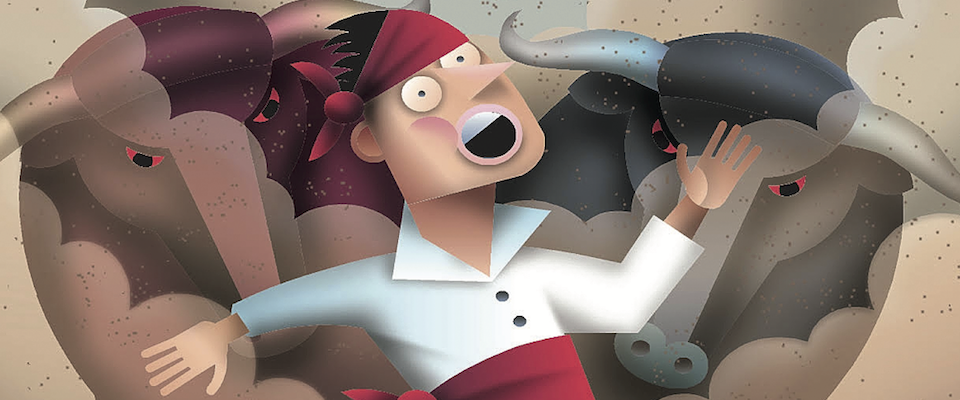Ester Hernández’s Sun Mad is her best-known piece, the one she’s most associated with. It now forms part of the San Francisco Legion of Honor exhibit, “Wild West: Plains to the Pacific,” through September 11.
Jim Ganz, who curated the show with Colleen Terry, says when they were looking for some political art to include in the show—and in their collection—Sun Mad seemed perfect. He says this print, alongside Matt Black’s photos of farm workers, adds a lot.
“It’s kind of like a bombshell in the space,” he said. “It’s very bold, very strong, and very explicit. It’s kind of great to see it in that gallery, making such a strong statement.”

Hernández is delighted that her piece based on the iconic red Sun Maid raisin box found in so many children’s lunch boxes has been included in the show. Her piece replaces the smiling woman on the box with a skeleton and the text under the logo reads, “Unnaturally grown with insecticides, miticides, herbicides, fungicides.”
The idea for an artwork addressing the damage of pesticides to the environment and to farm workers like Hernández’s parents, originated when she was visiting her mother in Dinuba, a small town in the San Joaquin Valley. It was summer, meaning the temperature was over 100, and Hernández was surprised to see her mother boiling water. When she asked why, her mother showed her a notice saying the water in the town was contaminated and suggesting everyone either buy bottled water or boil their own. Hernández wanted to take on the subject, but initially didn’t know how.
“It took me two years because I didn’t know what to say,” said Hernández in her sunny studio and living space in San Francisco’s Mission District. “I wasn’t sure what to do or if I should let it go like everybody else.”
It was a couple years later on another trip to see her mom that Hernández hit upon the idea after seeing the Sun Maid image along the highway.
Independent curator and art historian Tere Romo calls Hernández a genius for the way she uses colors that pull people in. Romo specializes in prints, graphics and Chicano art, and she calls this kind of printmaking efficient—delivering a strong message with some ink and paper and hard work.
“Berkeley really opened up the world to me … I was seeing prints of Goya and Posada and Lichtenstein, and there was a whole world there.”
“It’s very flat and the bright colors catch your attention, and she uses a recognizable symbol that lots of people can relate to,” Romo says. “It’s like Warhol’s Brillo boxes making a comment that art is a commodity. Here she’s taking a powerful image and saying you may think these are naturally grown grapes, and you put them in lunch boxes for your kids, but you’re actually giving them poison.”
Hernández graduated from UC Berkeley in 1976, and it was there that she became interested in printmaking. She says going to the university after spending some time at Laney College in Oakland made a huge difference to her development as an artist. “Going to Berkley was boom!” she says.
She started out studying anthropology, but having been an artist since she was a little girl, doing painting and pastels, she felt she needed a way to process what she was learning.
“Berkeley really opened up the world to me,” she said. “Aside from the physicality of making art, I took classes in African art and Japanese art and printmaking and papermaking. The library at Berkeley had beautiful handmade books that opened my mind to possibilities. I was seeing prints of Goya and Posada and Lichtenstein, and there was a whole world there.”
Outside her classes, Hernández met people at Berkeley who were from all over the world. In 1974, while still a student, Hernández joined Las Mujeres Muralistas, San Francisco’s first all-Latina mural collective.
“They were all Latina women from diverse backgrounds,” she said. “Some were saying art for art’s sake, and there were political artists and urban and rural and from the South American upper-class, middle-class, and it was a whole fabulous mixed bag.”
Now 71, Hernández is semi-retired from teaching at San Francisco’s Creativity Explored, where people with disabilities make and sell their art. She’s working on several projects, she says, going back and forth between more cultural work, and political pieces, such as one on domestic violence and PTSD.
She’s trying different techniques, creating mobiles and assemblage, but print, with its rich colors and surprises, is her great love. Getting involved in the Chicano civil rights movement came naturally to her, and she says the printmaking she learned at Berkeley gave her a good way to do that.
“I always enjoyed humor and irony, and printmaking doesn’t need a big fancy set up” she said. “It gave me a way to talk about the issue of pesticides.”




















